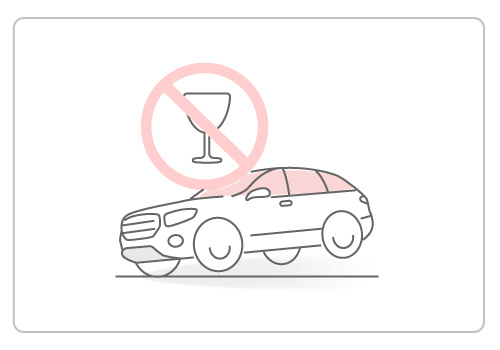
Written by Kayla Jane Barrie Updated on Dec 23, 2025 10 mins read

Impaired driving is not only dangerous, but it can also ruin lives. However, many drivers in Ontario continue to drive while impaired, and accidents remain a road safety threat.
While much work has been done, there is still a way to go. If you do your part, you can help make our roads safer.
In this blog, we’ll discuss impaired driving in Ontario. We’ll provide impaired driving definitions and discuss laws, penalties and statistics. Get essential information all drivers must know before getting behind the wheel.
Impaired driving is a serious offence. It refers to two main types of impairment – drug impairment and alcohol impairment. Driving with a blood alcohol concentration of 0.08 or higher is a criminal offence. You also face the consequences if your compound BAC is between 0.05 and 0.08. The term encompasses many impairments, such as driving high.
Driving while impaired puts people at risk, increases their chances of getting into an accident, and could even land them in jail, not to mention the severe insurance consequences. The criminal code of Canada and each province has laws prohibiting impaired driving.
Yes. There are provincial and federal laws outlawing impaired driving. You face criminal charges at the federal level, and you also face penalties for breaking provincial driving laws.
Is impaired driving an indictable offence in Canada? Yes, impaired driving is a crime. The definition of impaired driving under Section 320.14 of the Criminal Code of Canada is as follows :
Impaired driving definition by the Ontario Ministry of Transportation :
"Impaired driving means operating a vehicle (including cars, trucks, boats, snowmobiles and off-road vehicles) while under the influence of alcohol or drugs."
While the definition of what constitutes drinking and driving is clear, there is ongoing research and debate about the definition of drug-impaired driving.
In Ontario, an impaired driving charge will stay on your driving record for three years. It will take ten years to remove the conviction from your criminal history.
You can go to jail for impaired driving. Depending on what the charge and offence are will determine the length. For example, if it is your third impaired driving offence, and your BAC is over 80mg, you could face 120 days minimum jail time. If you cause bodily harm, you could face a maximum of 14 years in jail for impaired driving.
An impaired driving conviction will significantly impact your rates, how you are classified, and your ability to get coverage. Expect your car insurance to skyrocket with an impaired driving charge. Your rates can increase by up to 5 times your average premiums or more.
You may have issues getting covered if convicted of an impaired driving charge. You could be denied coverage or require high risk insurance.
Many people assume impaired driving and DUI are the same. DUI is one of the many types of impaired driving that focuses on drinking and driving and may cause you to need a DUI insurance. Impaired driving reflects a person's ability to operate equipment (vehicle, boat, plane, railway) while impaired by drugs or alcohol.
There are three main types of impaired driving, each of which can impact your ability to drive :
Other things impairing your driving ability include lack of sleep, distracted driving, and texting and driving.
As of December 18, 2018, Canada has new impaired driving and driving laws. The Government of Canada introduced changes to impaired driving laws in Canada, giving law enforcement new powers. Changes to both drug and alcohol impaired driving were introduced. The changes included in the legislation include :
The new laws also increase the maximum fines for most alcohol impaired offences. Changes to the interlock program and other changes were also proposed.
There are a variety of penalties for impaired driving. Your impaired driving penalties will depend upon whether you’ve been convicted of impaired driving in the past. Being convicted could lead to :
The criminal code of Canada impaired driving penalties and fines vary based on the charge and offence. Repeat offenders face greater fines, penalties, and jail time. These penalties are in addition to provincial impaired driving laws. The criminal code of Canada impaired driving penalties are as follows as outlined by the Department of Justice :
Charge
Penalty
Charge
Penalty
Charge
Penalty
The fines and penalties for impaired driving in Ontario vary. If you have a BAC of 0.05 to 0.08, you are considered in the warn range and will face administrative penalties. If you have a BAC of 0.08 or higher and are convicted you face a different set of penalties. The MTO outlines penalties for impaired driving convictions :
Here are the charges and penalties for drug impaired driving :
You cannot have any drugs or alcohol in your system if you drive a commercial vehicle. You will face the penalties below and additional penalties for impairment, just like any fully-licenced driver. You’ll also have to pay a licence reinstatement fee every time your licence is suspended.
First offence
Second offence
Third offence
Refusal to take a BAC roadside test or if a drug recognition evaluator determines you are impaired can result in serious penalties. Under Criminal Code section 320.15(1), it is a criminal offence to refuse to provide a roadside SFST, breath test, or oral fluid sample. Minimum penalties include :
If convicted, the driver will serve a jail term of a minimum of 30 days and up to 10 years.
Under the Highway Traffic Act, a driver can also be fined :
Statistics Canada’s most recent report on impaired driving, Impaired Driving in Canada, 2015, provides a great overview of impaired driving facts and stats. Here is what the report found :
"In spite of a decline in impaired driving rates over the past 30 years, impaired driving still remains one of the most frequent criminal offences and is among the leading criminal causes of death in Canada. In addition, while alcohol-impaired driving is down over the past several decades, drug-impaired driving is on the rise."
According a research report by MADD Canada, Total Crash Deaths Involving Alcohol and/or Drugs in Canada, by Jurisdiction, 2012 :
According to a study by the Centers for Disease Control, Canada is the leader of the drunk driving death rate among wealthy countries. According to the report, 34% of vehicle deaths in Canada were due to alcohol impairment. This is 3% higher than the United States (31%) and New Zealand (31%).
"Countries with the lowest percentage of fatal crashes tied to alcohol were Israel (3.2 per cent), Japan (6.2 per cent), and Austria (6.8 per cent)," says Douglas Quan on National Post.
Police use various tests to assess drivers' sobriety. In Ontario, they use these four tests :
There is zero tolerance for driving and driving and drug impaired driving for new drivers. New and young drivers in Ontario are not permitted to have any alcohol or drugs. This applies to all drivers with a G1 or G2 drivers licence. They will receive fines and penalties even if trace amounts are in their system. You must have a 0.00% BAC when driving, even if you are legal drinking age.
Impaired driving laws become more severe if you cause harm to others. Here is a look at the charges and penalties :
If you are convicted of impaired driving, you will be required to complete the Back On Track Program. This includes if you were convicted of driving while impaired by drugs. You can register for the program online and attend in person at a location in your city.
You will be required to complete an Education Workshop and a Treatment Workshop. The program takes 16 hours to complete and costs $634. If you do not complete the program, your licence will remain suspended.
It’s important to never put yourself in situations where you could get behind the wheel when impaired. Here are some common sense tips to help you avoid driving while impaired :
You can also help prevent others from driving while impaired. Don’t allow others to drive if they have been drinking. If you suspect a driver to be impaired, notify the police. Taking these steps can help keep our roads safe.
Impaired driving will affect your auto insurance for 6 years. During this time, you pay much higher rates.
Contrary to what you may think, there are no demerit points for impaired driving in Ontario. Impaired falls under the Criminal Code of Canada. There may be demerit points for other moving violations related to an impaired charge.
Blood alcohol concentration is something you hear about in relation to drunk driving. Blood alcohol concentration means the amount of alcohol a person has in their bloodstream at a given time.
A BAC of 0.08% means your blood supply has 0.08 parts of alcohol for every 1000 parts of blood. As your BAC increases, so does your level of impairment.
When a person has a BAC of 0.05%, they can experience minor impairments related to memory and reasoning. It can impair your ability to drive. At 0.05%, you have 50 milligrams of alcohol per 100 millilitres of blood in your system. It also means you have reached the warm level.
Never drive impaired. The consequences are severe and far-reaching. If you've been charged with impaired driving, contact a legal professional immediately. Remember, your safety and the safety of others is paramount.
| Categories | Auto |
|---|---|
| Tags | Auto Coverage |
Read our insurance blog to get helpful tips, information and news.
Has your car been totalled in an accident? Is your car a write off? Learn about vehicle write offs for a total loss insurance claim.
Get the facts on Toronto's auto theft problem. We break down the data, reveal the most-stolen vehicles (including the Honda CR-V and Lexus RX 350), and show which neighbourhoods are most affected.
Dive into the world of auto theft with our blog on the most stolen cars in Canada. See the most stolen cars across Canada, including provincial lists for Ontario and Quebec, and learn how high-risk models can affect your car insurance premiums.
Drive safe this winter! Check out these tips for driving in snowy and icy conditions in Ontario. Get other helpful info and FAQs on winter driving.